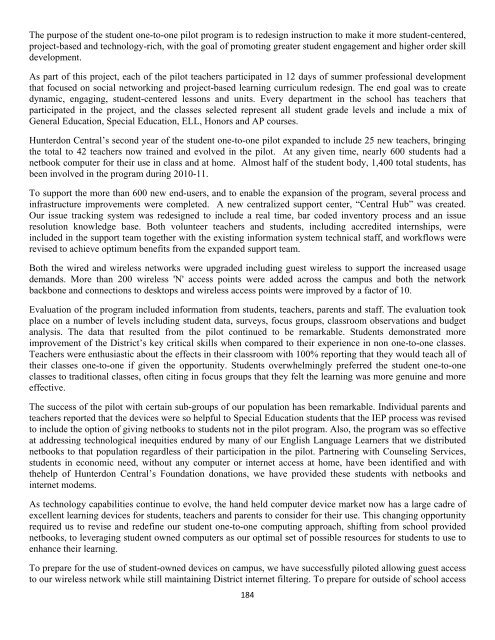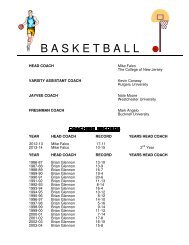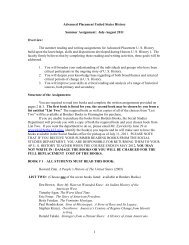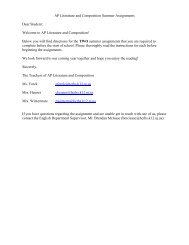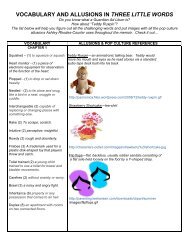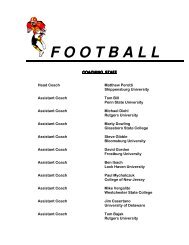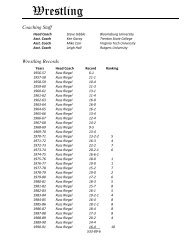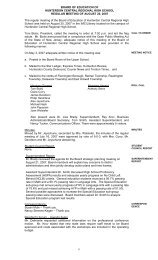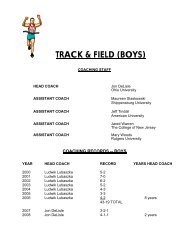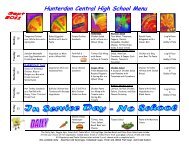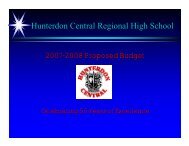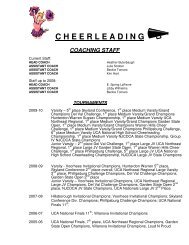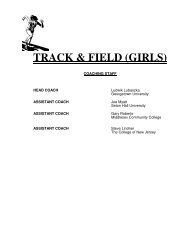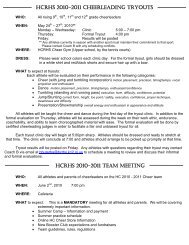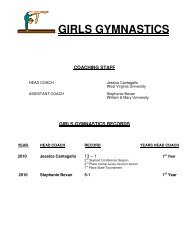HUNTERDON CENTRAL REGIONAL HIGH SCHOOL DISTRICT
HUNTERDON CENTRAL REGIONAL HIGH SCHOOL DISTRICT
HUNTERDON CENTRAL REGIONAL HIGH SCHOOL DISTRICT
Create successful ePaper yourself
Turn your PDF publications into a flip-book with our unique Google optimized e-Paper software.
The purpose of the student one-to-one pilot program is to redesign instruction to make it more student-centered,<br />
project-based and technology-rich, with the goal of promoting greater student engagement and higher order skill<br />
development.<br />
As part of this project, each of the pilot teachers participated in 12 days of summer professional development<br />
that focused on social networking and project-based learning curriculum redesign. The end goal was to create<br />
dynamic, engaging, student-centered lessons and units. Every department in the school has teachers that<br />
participated in the project, and the classes selected represent all student grade levels and include a mix of<br />
General Education, Special Education, ELL, Honors and AP courses.<br />
Hunterdon Central’s second year of the student one-to-one pilot expanded to include 25 new teachers, bringing<br />
the total to 42 teachers now trained and evolved in the pilot. At any given time, nearly 600 students had a<br />
netbook computer for their use in class and at home. Almost half of the student body, 1,400 total students, has<br />
been involved in the program during 2010-11.<br />
To support the more than 600 new end-users, and to enable the expansion of the program, several process and<br />
infrastructure improvements were completed. A new centralized support center, “Central Hub” was created.<br />
Our issue tracking system was redesigned to include a real time, bar coded inventory process and an issue<br />
resolution knowledge base. Both volunteer teachers and students, including accredited internships, were<br />
included in the support team together with the existing information system technical staff, and workflows were<br />
revised to achieve optimum benefits from the expanded support team.<br />
Both the wired and wireless networks were upgraded including guest wireless to support the increased usage<br />
demands. More than 200 wireless 'N' access points were added across the campus and both the network<br />
backbone and connections to desktops and wireless access points were improved by a factor of 10.<br />
Evaluation of the program included information from students, teachers, parents and staff. The evaluation took<br />
place on a number of levels including student data, surveys, focus groups, classroom observations and budget<br />
analysis. The data that resulted from the pilot continued to be remarkable. Students demonstrated more<br />
improvement of the District’s key critical skills when compared to their experience in non one-to-one classes.<br />
Teachers were enthusiastic about the effects in their classroom with 100% reporting that they would teach all of<br />
their classes one-to-one if given the opportunity. Students overwhelmingly preferred the student one-to-one<br />
classes to traditional classes, often citing in focus groups that they felt the learning was more genuine and more<br />
effective.<br />
The success of the pilot with certain sub-groups of our population has been remarkable. Individual parents and<br />
teachers reported that the devices were so helpful to Special Education students that the IEP process was revised<br />
to include the option of giving netbooks to students not in the pilot program. Also, the program was so effective<br />
at addressing technological inequities endured by many of our English Language Learners that we distributed<br />
netbooks to that population regardless of their participation in the pilot. Partnering with Counseling Services,<br />
students in economic need, without any computer or internet access at home, have been identified and with<br />
thehelp of Hunterdon Central’s Foundation donations, we have provided these students with netbooks and<br />
internet modems.<br />
As technology capabilities continue to evolve, the hand held computer device market now has a large cadre of<br />
excellent learning devices for students, teachers and parents to consider for their use. This changing opportunity<br />
required us to revise and redefine our student one-to-one computing approach, shifting from school provided<br />
netbooks, to leveraging student owned computers as our optimal set of possible resources for students to use to<br />
enhance their learning.<br />
To prepare for the use of student-owned devices on campus, we have successfully piloted allowing guest access<br />
to our wireless network while still maintaining District internet filtering. To prepare for outside of school access<br />
184


